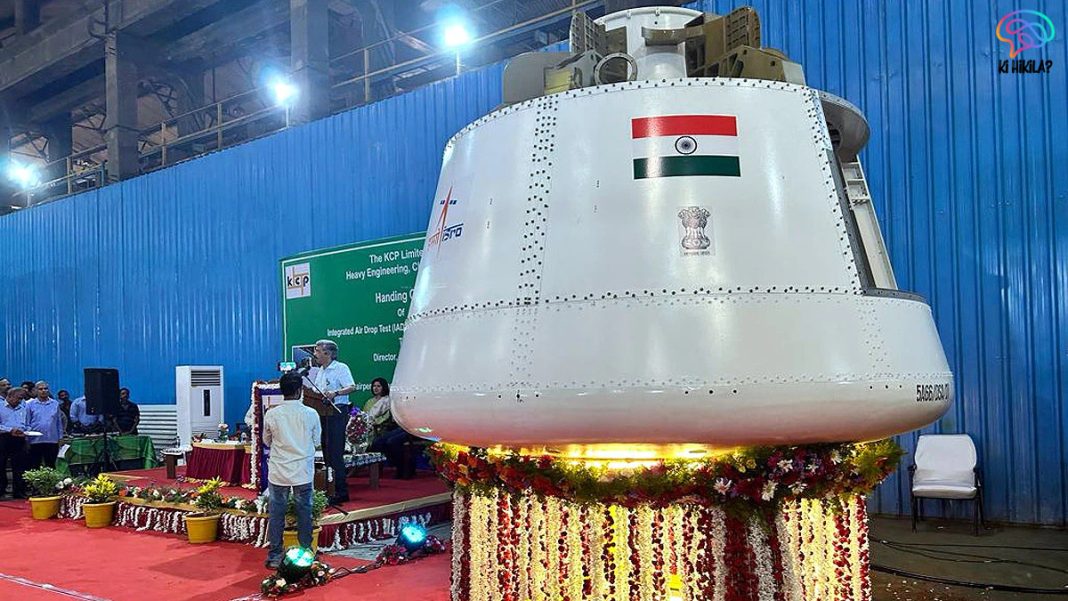Integrated Air Drop Test (IADT-1) was successfully conducted by the Indian Space Research Organisation (ISRO) on 24 August 2025, marking a major leap in India’s journey toward human spaceflight. As part of the ambitious Gaganyaan mission, the test validated the parachute-based deceleration system crucial for safely bringing astronauts back to Earth. This achievement demonstrates India’s growing capability to design, test, and human-rate spaceflight systems on par with global standards.
Integrated Air Drop Test (IADT-1) Overview
The IADT-1 involved dropping a five-tonne dummy crew module from an Indian Air Force Chinook helicopter at high altitude. As the capsule descended through the atmosphere, its parachute system deployed in a carefully timed sequence. Large main parachutes slowed the capsule to a controlled splashdown speed, simulating the conditions astronauts will face during re-entry and landing.
This successful demonstration confirmed the parachute system’s reliability under real-world conditions. During actual Gaganyaan missions, the system will operate after atmospheric re-entry, following initial deceleration by heat shields and drogue parachutes. The test has reassured engineers and mission planners about one of the most critical phases of the mission—crew recovery.
Significance of IADT-1 for Gaganyaan

Human spaceflight carries high risks, particularly during ascent, re-entry, and landing. The parachute deceleration system is vital for ensuring astronauts return to Earth safely. With IADT-1, ISRO validated the system’s capability to stabilize the crew module and control its descent rate for a secure splashdown.
This achievement boosts confidence in India’s ability to provide astronauts with a safe return environment. It also marks one of the last major milestones before uncrewed and, eventually, crewed flights under Gaganyaan. The success of IADT-1 aligns India with global standards of space safety and brings the country a step closer to joining the select group of nations capable of independent human spaceflight.
Collaborative National Effort Behind IADT-1
The success of Integrated Air Drop Test (IADT-1) highlights the collaboration between multiple national agencies. ISRO worked closely with the Indian Air Force, Defence Research and Development Organisation (DRDO), Indian Navy, and the Coast Guard to execute the test. Each agency played a crucial role in supporting air operations, safety mechanisms, and recovery protocols.
This inter-agency coordination is essential to human-rate launch and recovery systems. It also showcases India’s growing capability to manage highly complex space missions, where human lives are at stake.
Preparatory Work for Gaganyaan
ISRO has been working tirelessly on multiple aspects of the Gaganyaan mission, and the successful IADT-1 reflects years of preparation:
- Propulsion Systems: Crew and service module propulsion systems have been developed and tested.
- Life Support Systems: An engineering model of the Environmental Control and Life Support System (ECLSS) has been built to ensure astronauts’ survival in space.
- Crew Escape System (CES): Five types of motors for CES have been developed and successfully tested to guarantee astronaut safety in case of launch emergencies.
- Infrastructure: Facilities such as the Orbital Module Preparation Facility, Gaganyaan Control Centre, and astronaut training centres have been established. Additionally, modifications to the second launch pad have been completed to support human-rated missions.
This extensive groundwork ensures that India is not only testing systems in isolation but building an integrated, end-to-end human spaceflight capability.
Upcoming Missions After IADT-1
With Integrated Air Drop Test (IADT-1) successfully completed, ISRO is now preparing for the next milestones in the Gaganyaan programme:
- Test Vehicle-D2 (TV-D2): A flight to validate the Crew Escape System under dynamic conditions.
- Uncrewed G1 Mission: A demonstration mission to test the performance of propulsion units, parachute systems, and recovery operations in orbit.
- G2 Mission: Another uncrewed mission to further refine systems before the first human spaceflight.
Beyond Gaganyaan, India has an ambitious roadmap that includes establishing the Bharatiya Antariksh Station (BAS) by 2035 and planning for an Indian moon landing by 2040. These milestones will build on the foundation laid by Gaganyaan and the successful IADT-1 test.
India’s Space Vision Strengthened
The Integrated Air Drop Test (IADT-1) is not just a technical success; it is a symbol of India’s rising stature in global space exploration. It demonstrates India’s ability to handle the engineering complexities of crewed spaceflight, which requires an integrated approach combining propulsion, life support, crew safety, and recovery mechanisms.

By proving the reliability of the parachute-based deceleration system, India is addressing one of the most critical challenges in spaceflight—ensuring astronauts return safely. This puts the country firmly on track toward its goal of launching Indian astronauts aboard an indigenous spacecraft in the coming years.
Conclusion
The success of the Integrated Air Drop Test (IADT-1) marks a defining moment for ISRO and India’s Gaganyaan mission. It validates crucial safety systems, strengthens inter-agency collaboration, and sets the stage for upcoming uncrewed and crewed missions. With each milestone, India edges closer to becoming the fourth nation in the world to achieve independent human spaceflight capability.
As the nation prepares for uncrewed flights and eventual astronaut missions, the achievement of IADT-1 reminds us that India’s journey into space is not just about technology—it is about national pride, scientific advancement, and inspiring the next generation of explorers.




